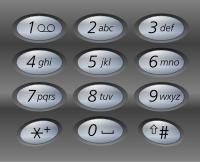Description
Given a string containing digits from 2-9 inclusive, return all possible letter combinations that the number could represent.
A mapping of digit to letters (just like on the telephone buttons) is given below. Note that 1 does not map to any letters.

Example
Input: “23”
Output: [“ad”, “ae”, “af”, “bd”, “be”, “bf”, “cd”, “ce”, “cf”]
解题思路
啊
一如既往
用最傻的办法
就是枚举
先把所有的键盘列出来
之后运算的过程和人手动运算过程一样
先把第一个数字对应的字符列出来
然后对每一个字符根据下一个数字再扩展成n个不同的字符串
放在代码里的话
就是数字数量(一共有多少个数字)
就是这个数字对应了几种字符
就是先前的答案库中已经有了多少种组合
假设之前已经有了3种组合,而当前数字又对应了3种字符,那么经过一次循环之后就会有9中组合,然后再对应下个数字进行新的排列组合
class Solution {
public List<String> letterCombinations(String digits) {
List<List<String>> phone = new ArrayList<>();
List<String> temp1 = new ArrayList<>();
temp1.add("a");
temp1.add("b");
temp1.add("c");
phone.add(temp1);
List<String> temp2 = new ArrayList<>();
temp2.add("d");
temp2.add("e");
temp2.add("f");
phone.add(temp2);
List<String> temp3 = new ArrayList<>();
temp3.add("g");
temp3.add("h");
temp3.add("i");
phone.add(temp3);
List<String> temp4 = new ArrayList<>();
temp4.add("j");
temp4.add("k");
temp4.add("l");
phone.add(temp4);
List<String> temp5 = new ArrayList<>();
temp5.add("m");
temp5.add("n");
temp5.add("o");
phone.add(temp5);
List<String> temp6 = new ArrayList<>();
temp6.add("p");
temp6.add("q");
temp6.add("r");
temp6.add("s");
phone.add(temp6);
List<String> temp7 = new ArrayList<>();
temp7.add("t");
temp7.add("u");
temp7.add("v");
phone.add(temp7);
List<String> temp9 = new ArrayList<>();
temp9.add("w");
temp9.add("x");
temp9.add("y");
temp9.add("z");
phone.add(temp9);
int i, j, k;
String t = "";
int[] nums = {3, 3, 3, 3, 3, 4, 3, 4};
int total_num = 1;
List<String> answer = new ArrayList<>();
List<String> temp_answer = new ArrayList<>();
if(digits.length() == 0)
return answer;
for(i = 0; i < nums[digits.charAt(0) - '2']; i++){
answer.addAll(phone.get(digits.charAt(0) - '2'));
}
for(i = 1; i < digits.length(); i++){
temp_answer.clear();
for(j = 0; j < nums[digits.charAt(i) - '2']; j++){
for(k = 0; k < answer.size(); k++){
temp_answer.add(answer.get(k) + phone.get(digits.charAt(i) - '2').get(j));
}
}
answer.clear();
answer.addAll(temp_answer);
}
List<String> new_answer = new ArrayList<>(new HashSet<>(answer));
return new_answer;
}
}
其他
- 在一开始的phone添加temp的时候……添加的只是指针,所以不能用一个temp然后clear完继续填充下一个,而需要8个不同的temp对phone的list进行填充
- 当对一个list用别的list进行add操作的时候,用的是addAll(another_list)
- 摸了一下discussion,快的人都用递归QuQ